Italian Greyhound
Canis lupus
The Italian Greyhound is a miniature dog with a big motor and personality!
Advertisement
Italian Greyhound Scientific Classification
- Kingdom
- Animalia
- Phylum
- Chordata
- Class
- Mammalia
- Order
- Carnivora
- Family
- Canidae
- Genus
- Canis
- Scientific Name
- Canis lupus
Read our Complete Guide to Classification of Animals.
Italian Greyhound Conservation Status
Italian Greyhound Facts
- Common Name
- Italian Greyhound
Italian Greyhound as a Pet:
- General Health
- Energy Level
- Shedability
- Trainability
- Intelligence
- Tendency to Chew
- Size
- Family and kid friendliness
- Yappiness / Barking
- Moderate
- Separation Anxiety
- High
- Preferred Temperature
- Average climate
- Exercise Needs
- Moderate
- Friendly With Other Dogs
- High
- Pure bred cost to own
- At least $500 from a reputable breeder
- Dog group
- Hound
- Male weight
- 7-14 lbs
- Female weight
- 7-14 lbs
This post may contain affiliate links to our partners like Chewy, Amazon, and others. Purchasing through these helps us further the A-Z Animals mission to educate about the world's species.
View all of the Italian Greyhound images!
The Italian Greyhound is a miniature dog with a big motor and personality.
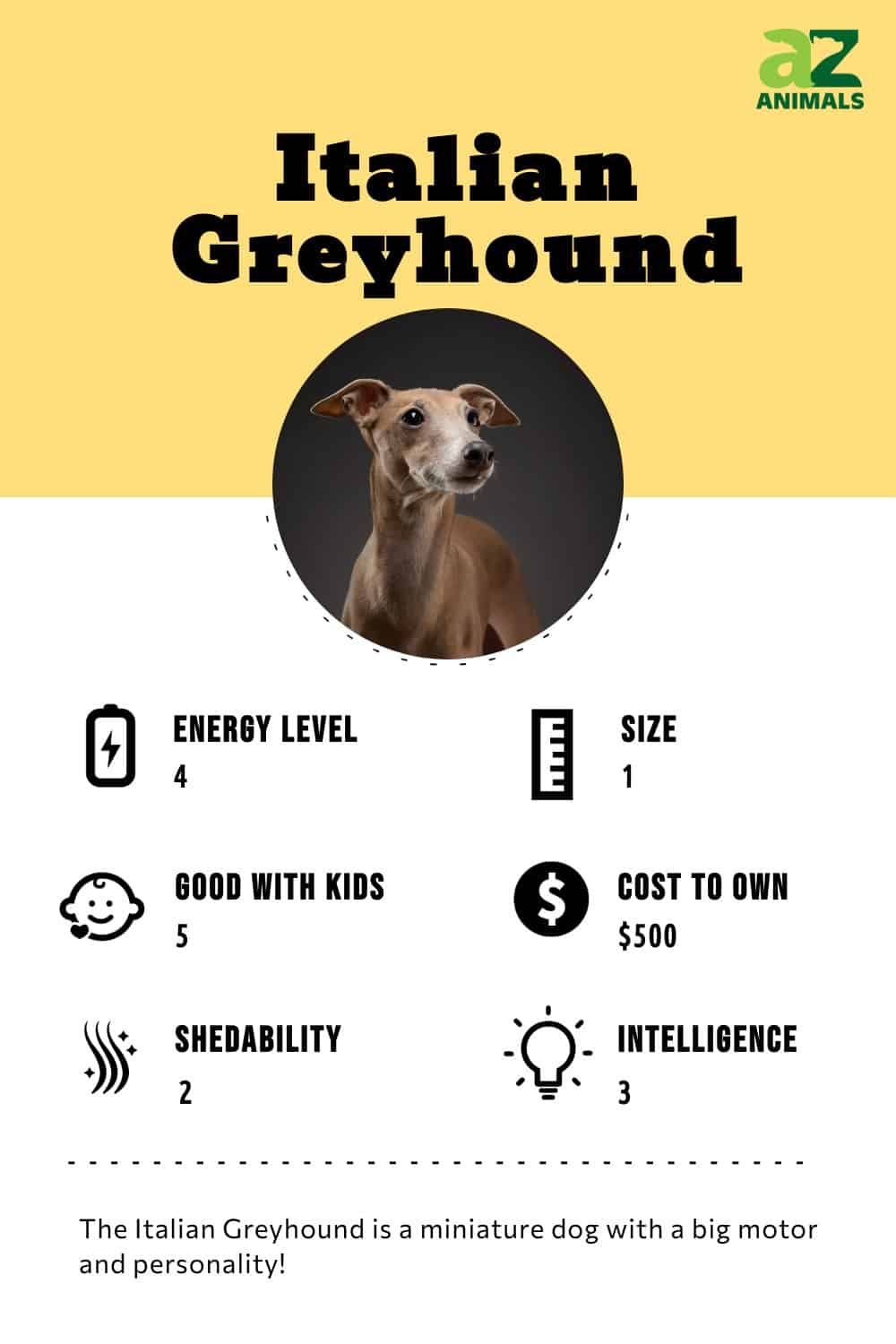
According to the American Kennel Club, this breed actually belongs to the toy group, but it has all the physical hallmarks of the venerable sighthound hunting group: a slender athletic body, a tucked-in abdomen, and a pointed and sleek snout. The fur is usually some combination of gray, black, or blue colors with white markings. Its appearance is well-adapted for the ultimate purpose of pursuing prey at a top speed of some 25 mph.
See all of our expert product reviews.
The Italian Greyhound is the smallest member of the sighthounds, also called gazehounds, that hunt by sight and speed rather than by scent. Sighthounds specialize in pursuing prey by keeping it in sight and then overpowering it with incredible speed and agility. Excellent eyesight, long legs, and large lungs provide these dogs with the athleticism it takes for high-speed chases. While it may have been used for hunting originally, today, the Italian greyhound is a popular companion and friend.
Evolution
The Italian Greyhound, in spite of its name, did not originate in Italy. Archaeological evidence suggests that the Italian greyhound was bred as a companion dog for nobility at least 2,000 years ago in the region that is now Greece and Turkey, during the time of the Roman Empire.
The popular little dog caught the attention of the Italians, who favored the pet during the Italian Renaissance and brought it into its own. The breed was part of a popular trend among aristocrats of owning miniature versions of popular dogs.
Italian Greyhounds can be seen with their well-to-do powers in many paintings of Renaissance masters – and made their way into royal households all across Europe. As with many dog breeds – Queen Victoria brought the Italian Greyhound to even greater popularity.
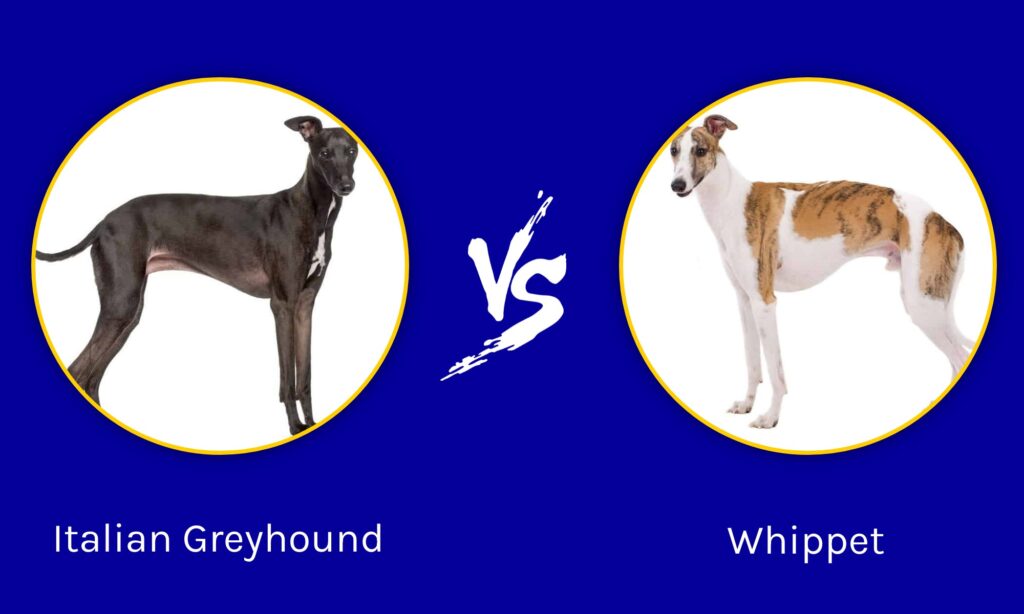
Italian Greyhound vs. Whippet
Because of their similar appearance, the Italian Greyhound and Whippet are sometimes mistaken for each other. The main differences are the Whippet’s larger size (20 to 42 pounds) and the wider variety of colors and patterns. Both have an intelligent and playful nature that makes them suitable as lovable companions.
Health and Entertainment for your Italian Greyhound
See all of our expert product reviews.
3 Pros and Cons of Owning an Italian Greyhound
| Pros! | Cons! |
|---|---|
| Agile and athletic The Italian Greyhound was bred for its excellent speed. | A very sensitive nature The Italian Greyhound may become easily discouraged by aggressive words or actions. |
| Friendly and carefree This breed is not high-strung. It likes to relax with its owner. | Stubborn This breed has a mind of its own. It is a good idea to keep it on a leash. |
| Small size This breed is suitable for owners who want a small companion. | Fragile Due to its small size and slender frame, this breed has a tendency to get hurt rather easily. |
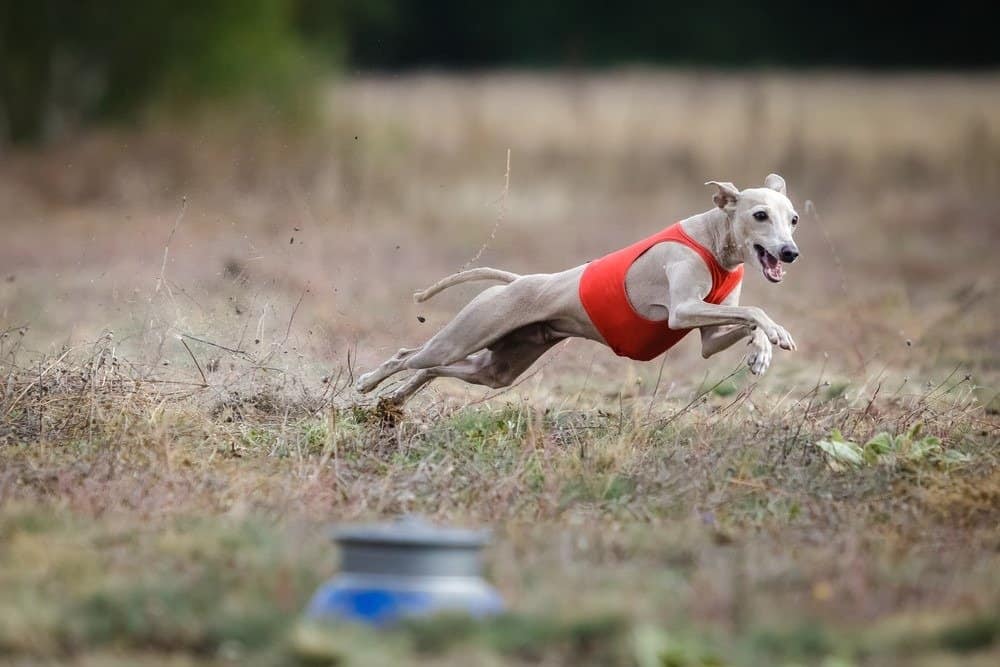
©krushelss/Shutterstock.com
Size and Weight
The Italian Greyhound is a small, miniature dog with exceptionally long legs. Even though it stands at some 15 inches, it actually weighs less than its height would suggest. There is little difference in the size between males and females.
| Height (Male) | 13 to 15 inches |
|---|---|
| Height (Female) | 13 to 15 inches |
| Weight (Male) | 7 to 14 pounds |
| Weight (Female) | 7 to 14 pounds |
Common Health Issues
The Italian Greyhound is a healthy breed with an average life expectancy of 13 to 15 years of age, but its body shape is a bit thin and fragile. Potential health complications include hypothyroidism (the underproduction of the thyroid hormone, resulting in lethargy and weight gain), auto-immune disorders (in which the immune system attacks the body’s own cells), progressive retinal atrophy (a deterioration in retinal tissue), patellar luxation (a misalignment of bones in the leg), hip dysplasia (abnormal development of the hip joint), and Legg-Calve-Perthes disease (when the blood supply to the hip joint is interrupted, causing the gradual weakening of bones).
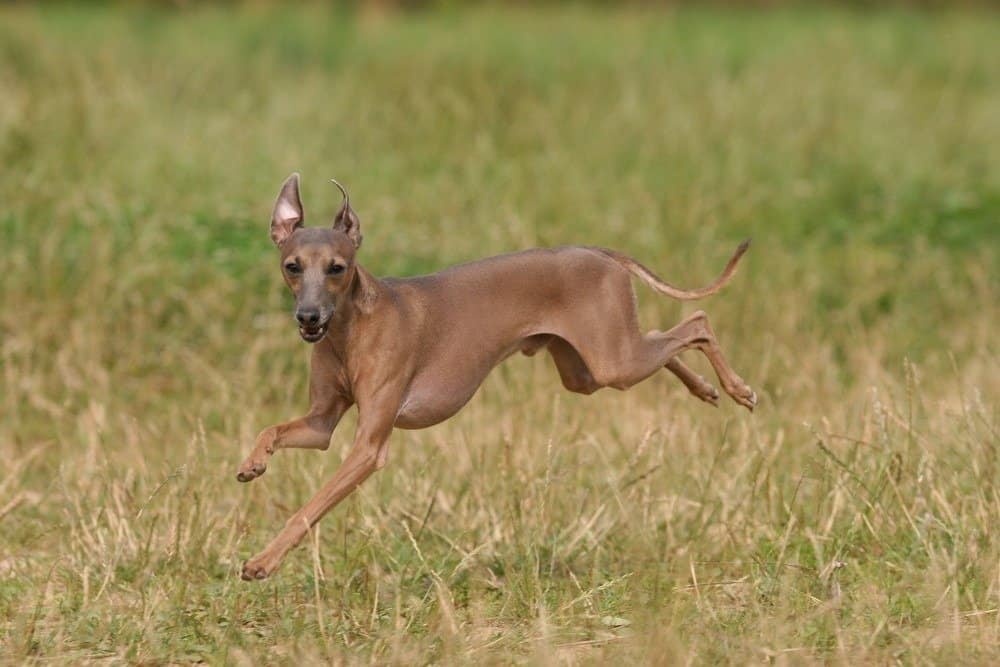
Italian greyhounds are generally healthy and can live up to 15 years or more.
©Utekhina Anna/Shutterstock.com
Cancer is also a leading cause of death among this breed. A responsible breeder should screen for health problems before they emerge. An adoption agency or rescue center should also keep the well-being of the dog in mind with early health checkups.
To sum up the common health issues:
- Cancer
- Hypothyroidism
- Eye Disorders
- Auto-immune Disorders
- Dysplasia
Temperament
The Italian Greyhound has a very calm and easy-going personality that tends not to get riled up too often. Aside from occasional bursts of energy (including its tendency to jump on furniture), one of the breed’s more appealing traits is its ability to just chill out around the home with its owner. Within some limits, it exhibits good behavior in both indoor and outdoor settings. If you enjoy the company of toy dogs but want the athleticism and diligence of hounds, then this breed may be right for you. As outgoing and affectionate as it is toward family and friends, though, this breed sometimes has a dismissive or indifferent attitude toward strangers.
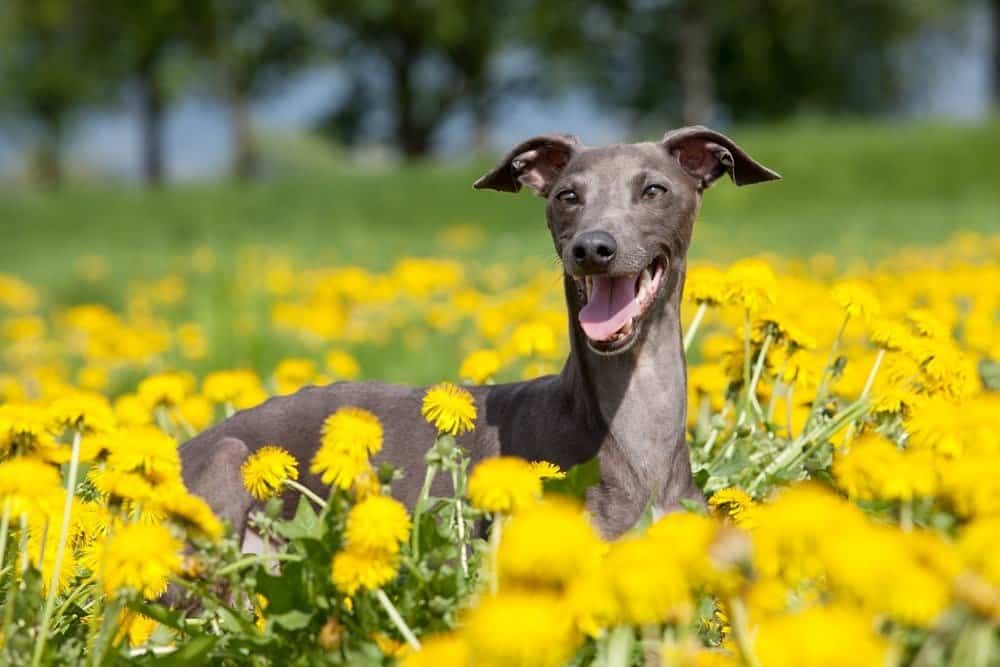
Italian greyhouds are difficult to house train – so a fenced yard is a good idea.
©Lenkadan/Shutterstock.com
How to Take Care of the Italian Greyhound
The Italian Greyhound is a medium-maintenance breed with several particular issues you need to be aware of. Because of its housetraining problems (even if you train it as a puppy), it is a good idea to have an enclosed yard and a dog door just in case it needs to go out. You should also factor in the price of annual health checkups in order to catch and treat health problems as early as possible.
The Best Dog Food for Italian Greyhounds
The Italian Greyhound requires half a pound to a full pound of high-quality dog food, preferably divided into two meals per day. The number of calories should be consistent with the dog’s activity level. Age should also be a factor in the type of dog food you buy. Treats can be given intermittently for good behavior but not often enough to cause weight gain.
The American Kennel Club recommends that an Italian Greyhound at the appropriate weight should have visible hip bones, but don’t deprive it of food so that the ribs show through the skin. If you need extra tips about the dog’s diet, then you should consult with the vet.
A-Z Animals says the best dog food for Italian Greyhounds is Wellness CORE Digestive Health Small Breed Dry Dog Food with Wholesome Grains.
With chicken and turkey for glucosamine and chondroitin sulfate, this recipe helps sustain sturdy joints. Fiber from healthy grains, with prebiotics and probiotics, enhances digestion to fortify the immune system, and taurine lends itself to healthier eyes.
You can find Wellness CORE Digestive Health Small Greed Wholesome Grains dog food on Chewy or Amazon.
- Chicken and brown rice recipe for small breeds
- Contains fiber-rich superfoods for healthy digestion
- Antioxidants and prebiotics for healthy immune system
Maintenance and Grooming
The Italian Greyhound is a seasonal shedder, but the hair is so short that it only requires the occasional gentle brush. The nails should be trimmed slightly with a grinding tool, but because it has a hare foot, the two middle nails can be left slightly longer than the others. Baths should be given whenever the dog is dirty from its outdoor adventures. The biggest problem, though, is the breed’s teeth. You should try to give it daily brushings and an annual dental checkup at the vet.
Greyhound Training
The Italian Greyhound does perform reasonably well with obedience, sports, and agility training, but you should be aware that this dog does have a mind of its own and may not respond perfectly to every command. It also has housetraining problems and may go on the floor. When this occurs, you should try not to discourage it with harsh words or aggressive motions. Due to its rather sensitive nature, it responds best to reward-based training and exuberant praise.
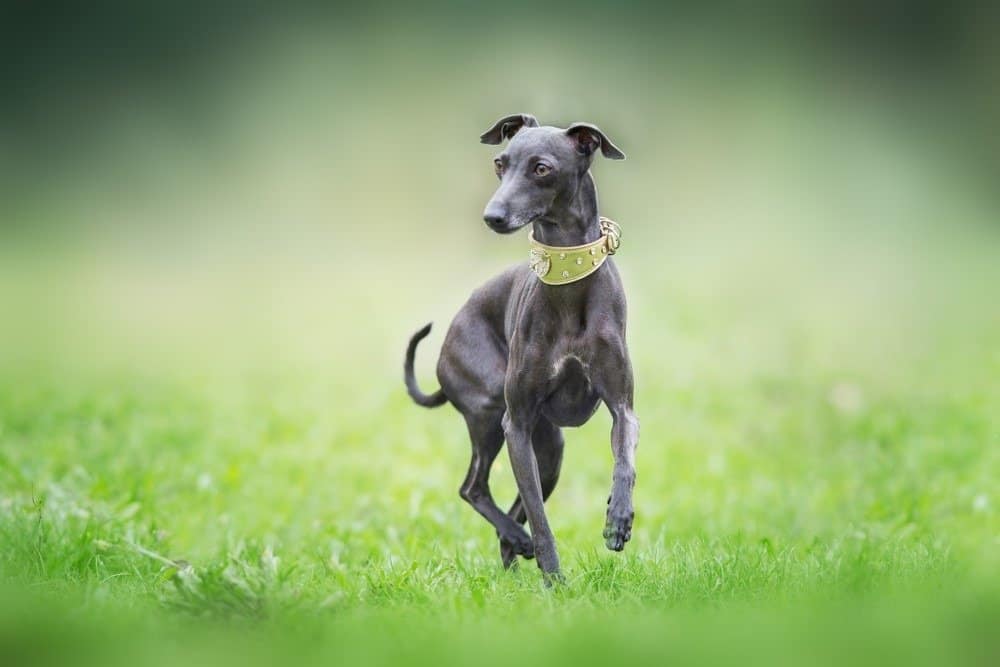
Italian greyhounds are natural athletes that require plenty of exercise.
©Kwadrat/Shutterstock.com
Greyhound Exercise
The Italian Greyhound needs around an hour of exercise or playtime every single day. This does not necessarily need to take place outside, but your dog will appreciate a good walk or run. Keep in mind that it is not a good idea to take this breed off the leash while out in the open because the instinct to chase other animals is very strong and could lead it into danger. This means the dog is definitely recommended for people with large enclosed yards.
You should also keep this dog cool and hydrated in warm weather. When you’re indoors, occasional toys, games, or tricks should suffice to keep this breed entertained. As long as the Italian Greyhound spends time with its owner, this breed is very adaptable and not picky about what fun it gets up to, but it is capable of tricks and feats of agility.
Greyhound Puppies
Italian Greyhound puppies are very eager to test boundaries and explore. But due to their fragile bodies, this can be a perilous endeavor, resulting in broken bones or bruises. You should keep a close eye on this dog since it has the tendency to jump up on furniture and play around. Puppies should also receive an early health screening to check for potential problems and receive important vaccines. If you purchase the dog from a shelter or rescue group, then it should be already caught up on some health screenings.
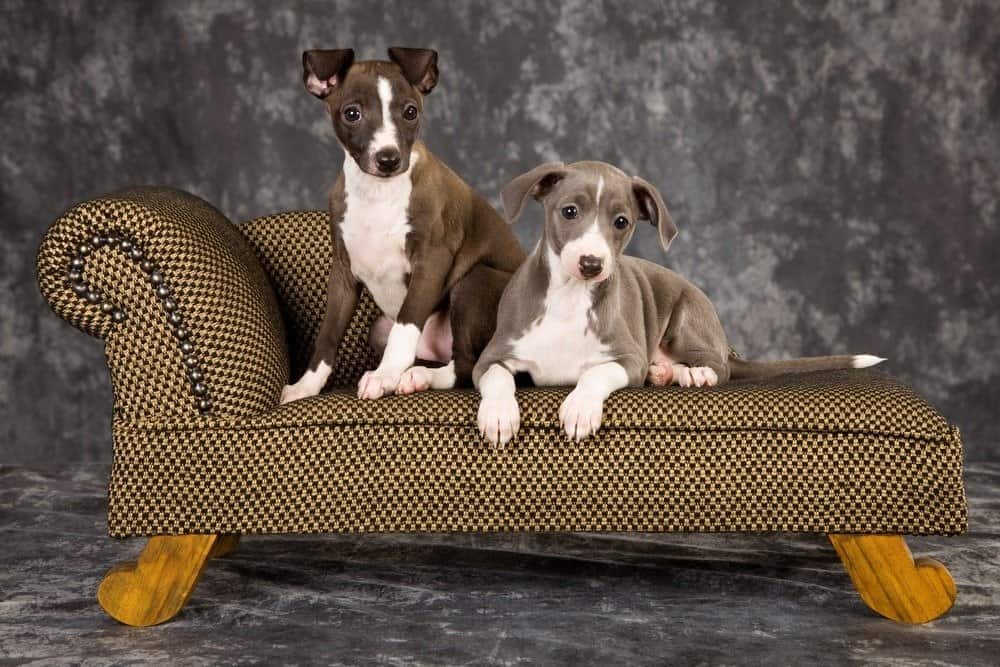
Italian greyhound puppies are fragile and need to be watched closely.
©Linn Currie/Shutterstock.com
Children and Italian Greyhounds
The Italian Greyhound is friendly and affectionate toward people of all ages, but because of its small size and fragility, it may not be a good idea to introduce this breed into homes with particularly young children. Keep a diligent eye on how your children interact with the dog and are prepared to intervene in case the experience goes poorly. You should also teach your children not to disturb or harass the dog when it’s trying to sleep or eat. The Italian Greyhound can be an excellent way to give your children a shared sense of responsibility for caring for another living being.
Dogs Similar to the Italian Greyhound
If you enjoy the company of sighthounds, then you may want to check out the following breeds:
- Greyhound – Originating from England, the Greyhound was first bred for hunting but became a very popular racing dog in the 19th and 20th centuries. It has a similar appearance and temperament as the miniature Italian Greyhound.
- Afghan Hound – Originating from the mountains of Afghanistan, this breed has a long-haired, distinctive appearance that now makes it more suitable as a show dog than an actual hunting dog. The Afghan Hound is a popular choice for dog shows around the world.
- Irish Wolfhound – Although this breed has a hard and shaggy double coat of fur, the Irish Wolfhound is a quintessential sighthound that also specializes as a guard dog. Reserved and intelligent, this breed is hardworking and reliable while performing tasks but also carefree and easy-going around the home and with family.
Famous Italian Greyhounds
The Italian Greyhound is well-represented in pop culture and history. Frederick the Great, Catherine the Great, Queen Victoria, James I, and members of the Medici family all owned the Italian Greyhound. More recently, it has been a favorite breed of many famous figures, including Matt Damon, Sigourney Weaver, and Seth Meyers.
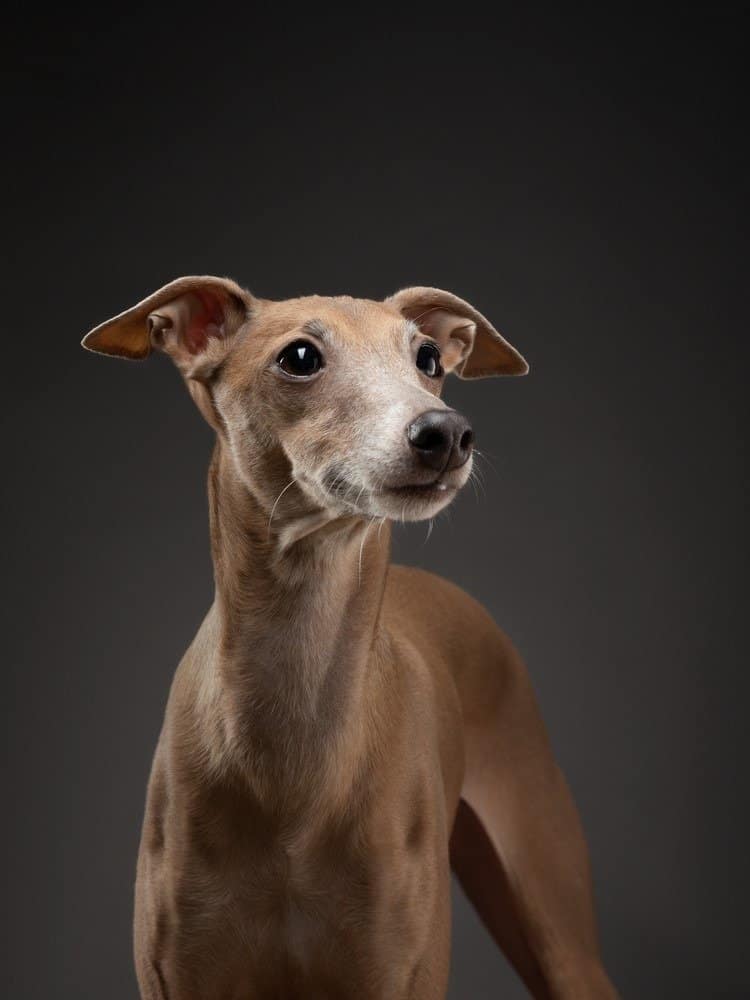
Italian greyhounds are popular among celebrities.
©dezy/Shutterstock.com
Popular Names for the Italian Greyhounds
According to the website Pet Press, here are 10 potential name ideas for the Italian Greyhound:
- Little Boy
- Bonbon
- Bunny
- Molly
- Toby
- Rusty
- Emma
- Teddy
- Sasha
- Twiggy
Italian Greyhound FAQs (Frequently Asked Questions)
Do Italian Greyhounds make good pets?
There isn’t really a bad breed of dog, just whatever breeds suit your situation and temperament. The Italian Greyhound is an excellent pet for people who enjoy small, friendly, athletic breeds that work well outdoors or indoors. You will need to deal with its stubborn streak, housetraining issues, and tendency to chase after small animals.
Do Italian Greyhounds bark?
The Italian Greyhound is not a huge barker, but it will alert its owner with a deep, resonant bark.
Can Italian Greyhounds be left alone?
The Italian Greyhound has a high degree of separation anxiety. It is not a good idea to leave this breed alone for long periods of time.
What is the difference between an Italian Greyhound vs. a Whippet?
The whippet is a larger breed of dog with more variations in its appearance. Both breeds are fast sighthounds with a friendly and calm personality.
Are Italian Greyhounds herbivores, carnivores, or omnivores?
Italian Greyhounds are Omnivores, meaning they eat both plants and other animals.
What Kingdom do Italian Greyhounds belong to?
Italian Greyhounds belong to the Kingdom Animalia.
What phylum do Italian Greyhounds belong to?
Italian Greyhounds belong to the phylum Chordata.
What class do Italian Greyhounds belong to?
Italian Greyhounds belong to the class Mammalia.
What family do Italian Greyhounds belong to?
Italian Greyhounds belong to the family Canidae.
What order to Italian Greyhounds belong to?
Italian Greyhounds belong to order Carnivora.
What type of covering do Italian Greyhounds have?
Italian Greyhounds are covered in Hair.
What is the scientific name for the Italian Greyhound?
The scientific name for the Italian Greyhound is Canis lupus.
What is the lifespan of an Italian Greyhound?
Italian Greyhounds can live for 15 years.
What is an interesting fact about Italian Greyhounds?
The Italian Greyhound is a miniature dog with a big motor and personality!
What's the difference between an Italian Greyhound and a Greyhound?
There are many differences between a Greyhound and Italian Greyhound. The Greyhound is much faster and larger than the Italian Greyhound, and Italian Greyhounds have slightly longer life expectancies.
Thank you for reading! Have some feedback for us? Contact the AZ Animals editorial team.
Sources
- American Kennel Club, Available here: https://www.akc.org/dog-breeds/italian-greyhound/
- American Kennel Club, Available here: https://www.akc.org/expert-advice/dog-breeds/whippet-vs-italian-greyhound/


















